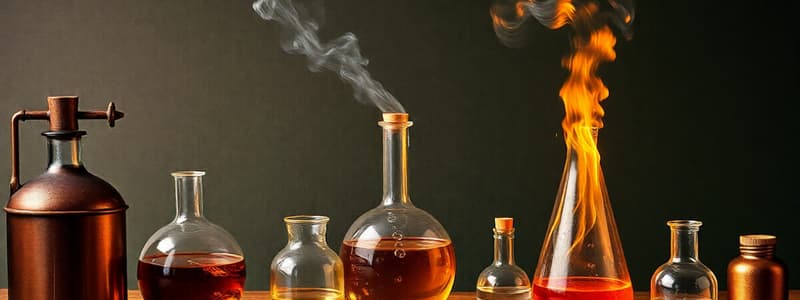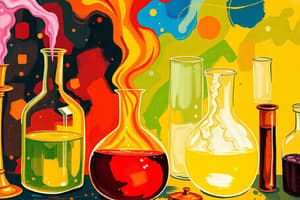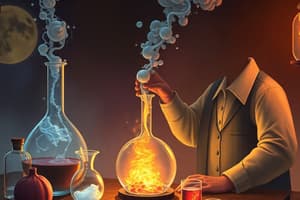Podcast
Questions and Answers
What was the name of the gas that Joseph Priestley discovered?
What was the name of the gas that Joseph Priestley discovered?
Dephlogisticated Air
What year did Priestley discover 'dephlogisticated air?'
What year did Priestley discover 'dephlogisticated air?'
1774
What did Priestley observe happening when he heated 'heavy air' (carbon dioxide)?
What did Priestley observe happening when he heated 'heavy air' (carbon dioxide)?
It bubbled up from the grain and dissolved in water.
Lavoisier found that when mercury oxide was heated what was released?
Lavoisier found that when mercury oxide was heated what was released?
Signup and view all the answers
Lavoisier rejected Priestley's ideas about dephlogisticated air.
Lavoisier rejected Priestley's ideas about dephlogisticated air.
Signup and view all the answers
What did Lavoisier rename 'inflammable air'?
What did Lavoisier rename 'inflammable air'?
Signup and view all the answers
Lavoisier found that water was actually a compound of hydrogen and phlogiston?
Lavoisier found that water was actually a compound of hydrogen and phlogiston?
Signup and view all the answers
What did Henry Cavendish discover?
What did Henry Cavendish discover?
Signup and view all the answers
When Cavendish applied heat to metals and added acid, what was the result?
When Cavendish applied heat to metals and added acid, what was the result?
Signup and view all the answers
Flashcards
Lavoisier's Experiment
Lavoisier's Experiment
Lavoisier's experiments showed that water consists of hydrogen and oxygen.
Hydrogen
Hydrogen
A colorless, flammable gas that combines with oxygen to form water.
Oxygen
Oxygen
A gas that supports combustion, discovered by Priestley.
Phlogiston Theory
Phlogiston Theory
Signup and view all the flashcards
Conservation of Mass
Conservation of Mass
Signup and view all the flashcards
Combustion
Combustion
Signup and view all the flashcards
Priestley's Discoveries
Priestley's Discoveries
Signup and view all the flashcards
Mercury Oxide Experiment
Mercury Oxide Experiment
Signup and view all the flashcards
Lavoisier's Law
Lavoisier's Law
Signup and view all the flashcards
Respiration
Respiration
Signup and view all the flashcards
Air Composition
Air Composition
Signup and view all the flashcards
Heat as Catalyst
Heat as Catalyst
Signup and view all the flashcards
Diamond Experiment
Diamond Experiment
Signup and view all the flashcards
Priestley and Plants
Priestley and Plants
Signup and view all the flashcards
Dephlogisticated Air
Dephlogisticated Air
Signup and view all the flashcards
Burning Candle Experiment
Burning Candle Experiment
Signup and view all the flashcards
Nitrogen
Nitrogen
Signup and view all the flashcards
Sulfur and Phosphorus
Sulfur and Phosphorus
Signup and view all the flashcards
Cavendish's Contribution
Cavendish's Contribution
Signup and view all the flashcards
Mint Experiment
Mint Experiment
Signup and view all the flashcards
Element Forms
Element Forms
Signup and view all the flashcards
Elementary Treatise on Chemistry
Elementary Treatise on Chemistry
Signup and view all the flashcards
Royal Gunpowder Administration
Royal Gunpowder Administration
Signup and view all the flashcards
Lavoisier's Marriage
Lavoisier's Marriage
Signup and view all the flashcards
Heated Air Observation
Heated Air Observation
Signup and view all the flashcards
Gaseous Products
Gaseous Products
Signup and view all the flashcards
Experiment Replication
Experiment Replication
Signup and view all the flashcards
Analytical Balance
Analytical Balance
Signup and view all the flashcards
Chemical Reactions
Chemical Reactions
Signup and view all the flashcards
Systematic Science
Systematic Science
Signup and view all the flashcards
Lavoisier's Influence
Lavoisier's Influence
Signup and view all the flashcards
Study Notes
Lavoisier's Experiments and Discoveries
- Lavoisier repeated experiments by English scientist Henry Cavendish
- Cavendish produced water when he poured acid onto metals
- Lavoisier found that heat acted as a catalyst to make hydrogen react more quickly with oxygen
- Lavoisier determined definitively that water is composed of hydrogen and oxygen, not phlogiston
- Lavoisier also studied combustion and respiration
Studying That Suits You
Use AI to generate personalized quizzes and flashcards to suit your learning preferences.
Description
Explore the pivotal experiments and discoveries made by Antoine Lavoisier, particularly his analysis of hydrogen and oxygen in water formation. This quiz covers Lavoisier's work on catalysis, combustion, and his critique of phlogiston theory. Test your understanding of these foundational concepts in chemistry!


